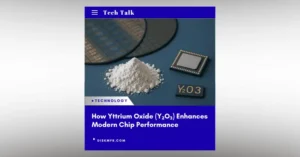According to a report by VietnamNet, an online newspaper under Vietnam’s Ministry of Information and Communications, the Vietnamese government has approved a plan to build a semiconductor wafer plant worth 12.8 trillion VND (approximately 500 million USD). This will be Vietnam’s first wafer plant. The report states that Prime Minister Phạm Minh Chính will personally review the selection of private companies collaborating with the government to implement this initiative.
Forming consortiums of foreign investors in the chip manufacturing sector is a common approach to providing patent protection and developing domestic chip technology. This is the path India is taking, but it has proven to be a long and frustrating process.
The report states that the government will provide funding of up to 12.8 trillion VND for the project, aimed at supporting defense, high-tech industries, and research needs. Vietnam also offers tax incentives, allowing chip companies to retain 20% of their taxable income, provided that the funds are reinvested into the country’s semiconductor ecosystem.
01
Vietnam’s Plan to Build a Semiconductor Plant Has Been in the Works for a Long Time
As early as the end of 2023, news emerged that Vietnam was in talks with semiconductor companies in the electronics industry to increase investment in the country.
At the time, two business officials, speaking on condition of anonymity, revealed that Vietnam planned to build its first computer chip factory. However, U.S. industry officials warned that the costs would be too high.
Vietnam is already an electronics hub. U.S. tech giant Intel has stated that its largest semiconductor packaging and testing facility is located in Vietnam. The country also has multiple chip design software companies.
Vietnam is formulating plans to attract more semiconductor investments, including foundries, which mainly produce computer chips.
Vu Tu Thanh, the head of the Vietnam office of the US-ASEAN Business Council, stated that they had already held talks with six U.S. chip companies at that time, including discussions with foundry operators. He declined to disclose the names of these companies due to ongoing negotiations.
Another official, also speaking anonymously, said that discussions with potential investors involved the U.S. company GlobalFoundries and Taiwan’s PSMC.
According to the official, the project aims to build Vietnam’s first chip manufacturing plant, which is most likely to produce less complex chips for automotive or telecommunications applications.
These business discussions took place after Vietnam and the U.S. improved diplomatic relations in September. Then-U.S. President Joe Biden visited the Vietnamese capital, Hanoi. The Biden administration described Vietnam as a potential “key player” in the global semiconductor supply chain.
GlobalFoundries stated that, at the president’s invitation, the company participated in a restricted business meeting during Biden’s visit. However, a source familiar with the matter said the company had no short-term plans for investment in Vietnam.
A GlobalFoundries spokesperson said, “We do not comment on market rumors.” PSMC did not respond to requests for comment.
Industry officials stated that, so far, the meetings have mainly been to gauge interest and discuss possible government financial support. Such support would aim to persuade these companies to set up local plants and offer incentives, including power supply, infrastructure, and a trained workforce.
The Vietnamese government has stated that it hopes to build its first chip manufacturing plant around 2030. On Monday, it also announced that semiconductor companies would receive “Vietnam’s highest incentives.”
Hung Nguyen, head of the supply chain program at Hanoi University’s Vietnam branch, told Reuters that Vietnam might also support domestic firms like state-owned technology company Viettel in building chip factories using imported equipment.
Vietnam’s military-run telecom company did not respond to requests for comment.
Robert Li, vice president of U.S. chip design company Synopsys, which has operations in Vietnam, urged the government to “think twice” before providing financial support or subsidies for building a semiconductor plant.
Speaking at the Vietnam Semiconductor Summit in Hanoi on Sunday, he noted that constructing a wafer plant could cost up to $50 billion. He added that this would require subsidies to compete with China, the U.S., South Korea, and the EU, all of which have announced semiconductor plant spending plans ranging from $50 billion to $150 billion.
John Neuffer, president of the U.S. Semiconductor Industry Association, also spoke at the summit. He suggested that the Vietnamese government focus on areas where the country is already strong in semiconductor manufacturing, such as assembly, packaging, and testing.
02
Vietnam’s Strong Position in Semiconductor Packaging
As mentioned earlier, John Neuffer suggested that Vietnam should first focus on OSAT (Outsourced Semiconductor Assembly and Test), a field in which the country excels. The Vietnamese government has also correctly identified the semiconductor industry as a key driver of future growth. Vietnam has become an important center for chip testing and packaging, with major companies like Intel and Amkor establishing large factories there.
Research shows that by 2021, semiconductors accounted for 19% of Vietnam’s total technology exports, up from 11% in 2011. Although its global market share remains small, Vietnam had the highest semiconductor export growth rate from 2011 to 2021, with a compound annual growth rate of 37.6%.
In 2023, Vietnam’s semiconductor equipment exports reached $7.53 billion, with over half of it going to the United States, followed by China and Canada. Recent statistics from Vietnam’s Ministry of Information and Communications (MIC) show that Vietnam has risen to become the third-largest chip exporter to the U.S., trailing only Malaysia and Taiwan. However, testing and packaging represent only a small portion of the semiconductor value chain, meaning Vietnam has yet to reap the enormous profits that the industry offers.
As early as 2012, the Vietnamese government had already identified semiconductors as a “national key product and service,” demonstrating its strategic foresight. In early 2023, during a visit by a U.S. business delegation, Vietnam’s Deputy Prime Minister reaffirmed this stance in a meeting with John Neuffer, the President and CEO of the U.S. Semiconductor Industry Association (SIA). He emphasized that semiconductors were Vietnam’s “top priority” and called on the U.S. to increase investment in the country’s semiconductor industry.
Vietnam has primarily focused on attracting investments from major global semiconductor companies. Intel was the first major company to operate part of its chip manufacturing process in Vietnam, delivering 3 billion semiconductor products worldwide from its Ho Chi Minh City plant by 2021. Other global giants, including Samsung, Qualcomm, Texas Instruments, SK Hynix, Hayward Quartz Technology, Synopsys, and NXP Semiconductors, have since entered the country. By the late 2010s, domestic companies like Viettel and FPT also joined Vietnam’s growing semiconductor industry, which is expected to be worth $6.16 billion by 2024.
Despite these advancements, Vietnam’s semiconductor industry remains heavily reliant on foreign direct investment (FDI). Its role in the supply chain is largely limited to assembly, testing, and packaging, although this sector has grown significantly in recent years.
For example, in October 2023, Amkor Technology held a grand opening ceremony for its new factory in Bac Ninh Province. The facility, located in the Yen Phong 2C Industrial Park, covers 57 acres (23.1 hectares) and offers turnkey solutions from design to electrical testing, beginning with advanced system-in-package (SiP) and memory production.
The project’s initial investment was $529.6 million. By July 2024, Amkor had received an additional investment certificate for $1.07 billion—11 years ahead of its original plan to invest $1.6 billion by 2035.
Amkor officially began operations in Vietnam in Q3 2024, with export revenue reaching 337.5 billion VND ($13.3 million) last year. The company also reported paying $3.5 million in taxes in 2024.
In February this year, Amkor Technology Vietnam announced plans to triple the maximum annual production capacity of its Vietnamese factory, increasing from 1.2 billion units to 3.6 billion units.
According to a recent project report, Amkor’s $1.6 billion factory in Bac Ninh aims to expand its annual output from 420 tons to 1,600 tons. The project does not sell its products within Vietnam. Amkor plans to begin partial operations and factory expansion in September, targeting full stabilization by October. Currently, the factory produces 420 million units annually (equivalent to 147 tons) and employs 1,200 workers. Once fully operational, the workforce is expected to grow to 5,700 employees.
However, Vietnam has yet to domestically produce any semiconductors.
For instance, 80% of chip companies’ capital expenditures go into wafer fabrication, a sector dominated by TSMC and Samsung, with only a few other companies (excluding Vietnamese firms) sharing the remaining global chip production capacity.
Semiconductor fabrication plants, or “wafer fabs,” are extremely expensive to build, with state-of-the-art facilities costing tens of billions of dollars. TSMC’s ongoing fab construction in Arizona has already reached a cost of $40 billion. Given these high costs, Vietnam plans to expand its investment in testing and packaging while ultimately aiming for the highly profitable chip design sector—the stage where companies like Nvidia generate substantial revenue.
To achieve this, Vietnam has outlined ambitious goals for semiconductor development.
03
Future Goals: Building Six Semiconductor Wafer Fabs
According to Vietnam’s semiconductor development strategy vision for 2030 and 2050, released by the Prime Minister in September last year, the country has set a target of achieving approximately $25 billion in annual semiconductor industry revenue by 2030.
Between 2030 and 2040, this figure is expected to surge to $50 billion per year, and by 2040-2050, it aims to reach $100 billion annually.
To achieve this goal, Vietnam will implement its strategy in three phases:
Phase One (2024-2030): The focus will be on attracting foreign investment. During this period, Vietnam will leverage its geopolitical stability and human resource advantages to attract foreign investors, striving to establish itself as one of the world’s key semiconductor workforce hubs. The country will also enhance its capabilities in semiconductor research, design, manufacturing, packaging, and testing.
By the end of this phase, Vietnam aims to establish at least 100 chip design companies, one semiconductor manufacturing plant, and 10 chip packaging and testing facilities.
The semiconductor industry is expected to generate $25 billion in annual revenue, contribute 10-15% in added value, and employ 50,000 engineers.
Phase Two (2030-2040): Vietnam will work towards becoming a global hub for electronics and semiconductors.
During this stage, the country plans to expand its semiconductor ecosystem by establishing at least 200 chip design companies, two semiconductor manufacturing plants, and 15 chip packaging and testing facilities. This will help boost the industry’s development and strengthen Vietnam’s autonomy in chip design and production.
The goal is to achieve $50 billion in annual revenue from the semiconductor industry, increase added value to 20%, and employ 100,000 skilled workers.
Phase Three (2040-2050): Vietnam aspires to become one of the world’s leading nations in the electronics and semiconductor industries.
The government aims to establish at least 300 design companies, three chip manufacturing plants, and 20 packaging and testing facilities. Once Vietnam gains full control over semiconductor research and development, the industry is expected to generate $100 billion in annual revenue, with an added value of 20-25%.
This phase will witness the formation of a fully self-sufficient semiconductor ecosystem in Vietnam.
To realize this ambitious vision, the government has outlined a series of tasks and solutions to expand the semiconductor industry in the coming years.
Vietnam will focus on developing specialized chip, electronics, and technology talent while attracting skilled professionals and foreign investors.
The government will establish a National Semiconductor Development Steering Committee, led by the Prime Minister, and a team of semiconductor industry experts, headed by the Minister of Information and Communications.
Additionally, the government will increase funding for semiconductor manufacturing, R&D, and electronic products while strengthening international partnerships in the semiconductor industry. Other initiatives include implementing toxic waste disposal regulations for resource extraction and chip manufacturing, enhancing environmental protection capabilities, and prioritizing green projects.
04
Final Thoughts
Beyond Vietnam, as reports indicate, Japan, the United States, Europe, and China are also heavily investing in the entire semiconductor supply chain, with a strong focus on wafer fabrication. Notably, the U.S. is using tariffs to pressure foundries like TSMC to build large-scale facilities on American soil—a factor that will undoubtedly become a key variable in the future of chip manufacturing.
Meanwhile, in Southeast Asia, Thailand, Malaysia, India, and even Singapore are eyeing the semiconductor sector with growing interest. Vietnam’s ambitious blueprint for chip manufacturing may not be as straightforward as it seems, given the increasing competition. However, these countries are also likely to benefit from the broader industry expansion.

Disclaimer:
- This channel does not make any representations or warranties regarding the availability, accuracy, timeliness, effectiveness, or completeness of any information posted. It hereby disclaims any liability or consequences arising from the use of the information.
- This channel is non-commercial and non-profit. The re-posted content does not signify endorsement of its views or responsibility for its authenticity. It does not intend to constitute any other guidance. This channel is not liable for any inaccuracies or errors in the re-posted or published information, directly or indirectly.
- Some data, materials, text, images, etc., used in this channel are sourced from the internet, and all reposts are duly credited to their sources. If you discover any work that infringes on your intellectual property rights or personal legal interests, please contact us, and we will promptly modify or remove it.







